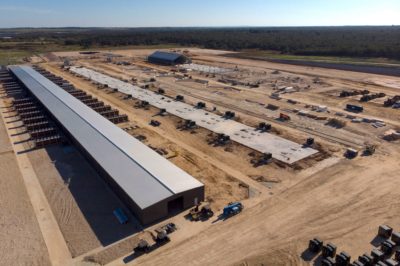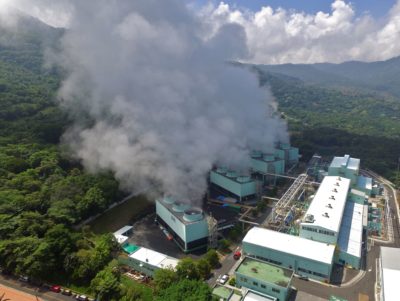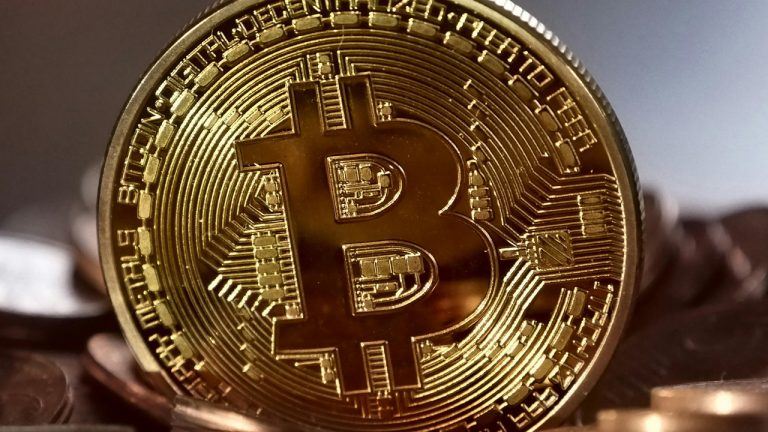The first time Jackie Sawicky learned that a Bitcoin mining operation was coming to Corsicana, a rural Texas city 60 miles south of Dallas, was on April 27, when she happened upon a Facebook video of a meeting at the local public library. The featured speaker was Chad Everett Harris, the upbeat executive vice president of Riot Blockchain, a Bitcoin mining company based in Castle Rock, Colorado. Bald and comfortably plump, Harris wore a suit jacket and open-collared shirt over blue jeans and delivered his message with the verve of a motivational speaker.
“We’re coming to Corsicana to build the largest [Bitcoin mining facility] in the world,” Harris announced, describing the four-building, 400,000 square-foot complex that will occupy 265 acres with number-crunching machines. “We turn energy into opportunity.”
Riot already operates the largest Bitcoin mine in the country in Rockdale, Texas. When someone in the audience asked Harris what drew him to Corsicana, the seat of Navarro County (pronounced “Nah-verr-o” in local parlance), he answered without hesitation. “The Navarro Switch!” he said, referring to part of the 192-mile, 345-kilovolt transmission line that moves power from West Texas to eastern parts of the state, where demand is high. “And water,” he added. “You can pay a lot to bring power somewhere. But you can’t get water.”
“He literally told us,” Sawicky says, “that he was coming to exploit our resources.”
By some estimates, the world’s Bitcoin mining operations had an annual energy budget equal to the nation of Argentina.
To some people, Bitcoin — the most valuable and well-known of the 10,000 or so currently circulating cryptocurrencies — is nothing more than a pyramid scheme; to others, it represents the future of money: decentralized, unregulated, and tracked on a virtual ledger in the digital cloud that everyone can inspect, known as a blockchain. But its production consumes dizzying quantities of electricity. In May of 2022, the world’s sum total of Bitcoin mining operations had an annual energy budget nearly equal to the entire country of Argentina, or the Czech Republic, or, according to Cambridge University’s Bitcoin Electricity Consumption Index, all the tea kettles in England boiling water for 26 years.
In warmer climates, cryptocurrency-mining by the Bitcoin method, known as “proof of work,” typically needs water to cool those machines running fast and hot as they play the Bitcoin lottery (Riot says it will use a new technology in Corsicana that reduces water use). Proof-of-work mining is essentially a high-stakes guessing game: Computers spend all day throwing out random 64-digit numbers until one matches the “right” number, as determined by Bitcoin’s consensus-managed protocol. On the worldwide network of Bitcoin servers, “you have 200 quintillion guesses every second of the day nonstop,” explains Alex de Vries, a researcher at the School of Business and Economics at the Vrije Universiteit Amsterdam. “And even despite that, only one machine gets it right every 10 minutes.”
The correct answer gets logged on Bitcoin’s blockchain, and the winner gets a reward: 6.2 Bitcoins. That’s not as much money as it used to be: In the coin’s current slump, each coin nets about $20,000, down from a high in November 2021 of just under $68,000.
Riot Blockchain's Bitcoin mining facility in Rockdale, Texas under construction in 2021. Mark Felix / AFP via Getty Images
Due to its high demand for electricity, proof-of-work cryptocurrency mining has not been welcomed in every corner of the world. Miners seek cheap energy to maximize their profits, but their energy-intensive activities typically drive electricity costs up for everyone. Even when mining plants run on renewable energy, critics say, they often exploit existing clean energy resources at the expense of ordinary consumers, who are then forced to buy more expensive, and often dirtier, power.
In Bonner, Montana, a small city in Missoula County, the Bitcoin company HyperBlock set up in 2016 and almost immediately began cutting into the community’s supply of hydropower from the Salish-Kootenai Dam; County Commissioner Dave Strohmaier called the plant’s energy use “grotesque” and equal to as much as one-third of the county’s household demand. HyperBlock went bankrupt when Bitcoin plummeted at the start of the COVID pandemic. The county subsequently enacted a first-of-its-kind zoning ordinance requiring, among other things, that cryptominers supply their own, new renewable energy sources.
A similar scenario has played out in upstate New York. The region initially drew cryptominers with its abundant supply of cheap hydropower electricity from the 2.6 gigawatt Niagara Power Project. In 2017, when the Bitcoin company Coinmint set up in the vacant space behind the Family Dollar Store in Plattsburgh, a city of less than 20,000 residents, electricity costs were one-third of the national average. Bitcoin miners had registered as industrial consumers, says Colin Read, a professor of economics and finance at the State University of New York, Plattsburgh, who was also Plattsburgh’s mayor at the time. “And our industrial rate was less than 2 cents per kilowatt hour, which might be the lowest in the world.”
But Plattsburgh, which manages its own municipal utility, also has a monthly quota for electricity use. If the city exceeds that quota, it has to go looking elsewhere for electricity, forcing everyone’s utility bills up. In the winter of 2018, residents who heated their homes with electricity saw costs rise 30 to 40 percent, according to Read.
The United States is now home to 40 percent of the world’s crypto-mining business, with one-quarter of that in Texas.
Plattsburgh quickly imposed a moratorium on new crypto-mining operations while city officials figured out how to make it more efficient. “We imposed a regulation that says Bitcoin miners have to recycle a share of their heat,” Read says. After that, “they simply weren’t interested in coming here anymore. They always migrate to the places with the least regulation.”
Bitcoin mining has faced similar challenges in other countries. China, despite once being the world’s largest supplier of the application-specific integrated chips used in crypto-mining, declared all virtual currency activities illegal in the fall of 2021, in part because the mining “produces high carbon emissions.” (The country’s central bank also wants to develop its own digital coin.) Iceland’s national power company, Landsvirkjun, which once attracted cryptocurrency miners with its climate-friendly geothermal energy, began denying power to new miners in late 2021. Even Iran, where the oversight-free nature of peer-to-peer currency had enabled entrepreneurs to dodge international sanctions, found crypto-mining so burdened its grid that the government was forced to ban it — first for four months beginning in May 2021, then again the following December, as heating demands strained its electricity supply.
Neither energy consumption nor water nor Bitcoin’s volatility have deterred the elected leaders of Texas, who have welcomed the industry with effervescent enthusiasm. “Blockchain is a booming business Texas needs to be involved in,” Governor Greg Abbott tweeted last summer after signing into law a bill recognizing cryptocurrency in the state’s commercial code. (Texas was the second state to do so, after Wyoming.) And the miners have come, reveling in the state’s wide-open spaces, where the rattling fans that cool their hard-working rigs can operate without disturbing the neighbors, and abundant cheap energy keeps overhead low. Whereas once China hosted 75 percent of the crypto-mining business, now the United States is home to 40 percent of the activity, and one-quarter of it happens in Texas.
An armed guard patrols rows of computers at a crypto-mining operation in Bratsk, Russia. Andrey Rudakov / Bloomberg via Getty Images
Three days after Harris’s announcement at the Corsicana library, Jackie Sawicky founded Concerned Citizens of Navarro County to marshal opposition to Riot Blockhain’s plans for Corsicana. More than 600 people have signed a petition to stop the mine, and the group has more than 500 members on its Facebook page, where Sawicky and others post news stories about their state’s grid and water woes.
“We’re going to be paying increased electricity bills to upgrade ERCOT’s grid to accommodate these places,” she says, referring to Texas’s independent system operator, the Electric Reliability Council of Texas. The grid notoriously slumped under the strain of winter storm Uri in 2021, cutting power to more than 4 million homes and businesses, many of which relied on electricity to heat their buildings. Hundreds of people died from extreme cold exposure or the failure of medical equipment.
Harris has insisted in news stories that mining only uses excess power when demand is light; when the grid is overloaded, ERCOT issues them credits for shutting down, which miners can do within minutes. In that way, he says, Riot’s participation in “demand response” can actually stabilize ERCOT’s unsettled and isolated grid.
That’s at least partially true, says de Vries, the Dutch researcher. But the company’s participation in demand response isn’t exactly altruistic. Riot Blockchain’s filings with the Securities Exchange Commission, he points out, state plainly that the company will pay a mere 2.5 cents per kilowatt hour for its electricity, a full 10 to 11 cents less than the going residential rate. That figure “represents our contractual cost of power,” confirms Trystine Payfer, spokesperson for Riot Blockchain, minus the credits the company earns for participating in the utility’s “demand-response” program. That program is a sweet deal: It means that, when electricity supply is tight and Riot voluntarily shuts down, the company earns credits for power. If electricity prices shoot up to $9 per kilowatt hour, as they did during 2021’s winter storm, it might be more profitable to unplug from the grid than to keep mining Bitcoin.
Some Bitcoin miners have tried to eliminate their pressure on utilities by buying up fossil-fuel plants to power their activities.
“Our utility provider does not actually pay us the credited amount each month,” Payfer stresses, “rather, we have the right to apply the credits toward future [bills].”
Nevertheless, de Vries argues, it’s hard to see how that won’t drive prices up for everyone. The utility still has to buy the power, he notes, and the credits it issues under the demand-response program come from the same pool of money other customers fund when they pay their bills.
“We have a saying here in Texas,” Sawicky says. “Don’t piss on my boots and tell me it’s raining. And that’s pretty much what’s going on.”
Not every community has fought Bitcoin mining the way Sawicky’s group has. Riot Blockchain’s Rockdale facility, initially built on 100 formerly forested acres near the former Alcoa aluminum plant, has by most accounts been a boon to the community, which had long been a company town revolving around the now-shuttered factory. “We rebuilt the animal shelter,” Harris said at the Corsicana launch meeting. “When I learned kids didn’t have lights in their parks, we put lights in the ball fields. For a year, we rented an entire hotel.” Bitdeer, another Bitcoin mining company, set up shop nearby and bought emergency ventilator equipment for Rockdale’s volunteer firefighters.
But Corsicana, Sawicky argues, is different. “People came to Navarro County for farming and ranching and open space. We have wildlife. We have two pair of nesting bald eagles and tons of migrating birds. I worry about all of them.”
A geothermal plant in El Salvador that powers Bitcoin mining on site. VLADIMIR CHAMORRO TOBAR / AFP via Getty Images
Mostly she worries about electricity prices. Electricity prices in Texas are already up 70 percent over what they were a year ago. “We have a 15 percent poverty rate in Navarro County,” Sawicky notes. “We can’t pay more for electricity than we already do.”
Some ambitious Bitcoin miners have tried to eliminate their pressure on utilities by buying up their own fossil-fuel plants to power their mining activities. The coal-fired Greenidge power plant in New York’s Finger Lakes region, decommissioned in 2010 and revived seven years later as a gas-fired plant, in 2021 became a gas-powered Bitcoin mine; 120 miles west, in North Tonawanda, Canadian cryptominer Digihost intends to inhabit a still-operational gas-fired power plant using the plant’s power to mine its coin.
But more such projects in New York State could be in peril if Governor Kathy Hochul signs a pending bill instituting a two-year moratorium on new fossil-fueled proof-of-work crypto-mining in the state. The bill, passed by New York legislators on June 3, is designed to give the state time to evaluate how the technology fits within the state’s 2019 climate law, which commits New York to 100 percent zero-emissions electricity by 2040. The state law would be the first in the country restricting cryptocurrency mining.
Read doesn’t think the bill does enough. “Even if Bitcoin miners aren’t using hydrocarbons,” he says, “they’re displacing renewable energy” that would be used for other purposes. “And there’s no easy way to measure that.” Bitcoin, he says, will continue to increase the use of fossil-gas-fired power in the state, regardless of whether miners use clean energy or not. Nor has Governor Hochul committed to signing the legislation. Both she and New York City Mayor Eric Adams, who has asked her to consider a veto, have received significant donations from the crypto industry.
Some companies plan to capture methane from oil and gas drilling and divert it to power plants dedicated to Bitcoin mining.
There are ways to reduce the energy use and, consequently, the climate impact of cryptocurrency mining. Some energy companies have developed plans to capture fugitive methane from oil and gas drilling and divert it to electricity plants dedicated to Bitcoin mining. Crusoe Energy has already begun such operations in North Dakota and Colorado and plans to expand to Texas and New Mexico. Another company, the Casper, Wyoming-based JAI Energy was specifically founded to take advantage of waste gas to mine Bitcoin. The process could theoretically be a net win for the climate, as methane from the oil fields is typically ether flared or vented, releasing fast-acting planet-warming gases into the atmosphere.
An even better alternative, Read says, is to trade proof-of-work mining for another process, known as “proof of stake.” It doesn’t use exorbitant amounts of energy, because it doesn’t involve gazillions of computers taking 200 quintillion stabs per second at a random number. “Instead of trying to win the lottery in 10 minutes,” he explains, you put down a large deposit proving you have a stake in the outcome. “You ensure you don’t corrupt the system” when you verify an entry on the cryptocurrency’s blockchain. If you fail to verify properly, you lose your investment.
Proof-of-stake “means you can have everything in crypto without having all these environmental problems,” Read says. Several currencies, such as Cardano and Peercoin, use proof-of-stake exclusively; Ethereum, the second most-valuable coin next to Bitcoin, is in the process of transitioning to proof-of-stake.
In fact, “almost all cryptocurrency currencies are mined with proof-of-stake right now,” Read says. “We just don’t hear about it so much because Bitcoin represents 99 percent of all capitalization in cryptocurrency.” There may come a day when you get auto and home loans on a smartphone with decentralized, digital currency. But that currency probably won’t be energy-devouring proof-of-work Bitcoin.
“Bitcoin,” Read says, “is cryptocurrency’s Model T.”

You can get bonuses upto $100 FREE BONUS when you:
💰 Install these recommended apps:
💲 SocialGood - 100% Crypto Back on Everyday Shopping
💲 xPortal - The DeFi For The Next Billion
💲 CryptoTab Browser - Lightweight, fast, and ready to mine!
💰 Register on these recommended exchanges:
🟡 Binance🟡 Bitfinex🟡 Bitmart🟡 Bittrex🟡 Bitget
🟡 CoinEx🟡 Crypto.com🟡 Gate.io🟡 Huobi🟡 Kucoin.























Comments